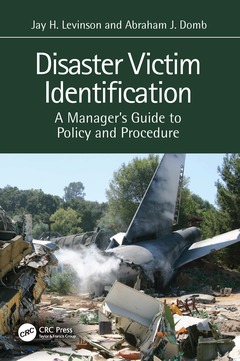Description
Disaster Victim Identification
A Manager's Guide to Policy and Procedure
Authors: Levinson Jay H., Domb Abraham J.
Language: English
Subjects for Disaster Victim Identification:
Keywords
DVI; accident; disaster; explosion; plane crash; train derailment; emergency; victim identification; mass disaster; mass casualty; emergency response; emergency planning; flooding; hurricane; tornado; forest fire; landslide; tsunami; accidental death; autopsy; medical examiner; human remains; Ante Mortem; NGO Volunteer; External DNA; DNA Comparison; Ichilov Hospital; DNA Specimen; American Psychiatric Association; Smart Phones; FEMA; DVI Team; NGO’s Activity; Table Top; Forensic Odontology; DVI Process; Interpol DVI; Professional Responder; Forensic Anthropology; Positive Comparison; Table Top Exercises; Public Inquiries Center
68.67 €
In Print (Delivery period: 14 days).
Add to cartPublication date: 06-2023
· 15.6x23.4 cm · Paperback
154.17 €
In Print (Delivery period: 14 days).
Add to cartPublication date: 06-2023
· 15.6x23.4 cm · Hardback
Description
/li>Contents
/li>Readership
/li>Biography
/li>
Disaster Victim Identification: A Manager?s Guide to Policy and Procedure?s guiding thesis explains why disaster victim identification (DVI) must be fundamentally integrated?at the outset?into general disaster planning and operations procedures. By doing so, it allows for pre-event assessment of any risks and vulnerabilities, in coordination with planning and response agencies, so that the on-site response isn?t the first time they have communicated and worked together.
The book outlines the importance of exercising, interagency memoranda of understanding (MOU), and coordination in advance to provide the best, most effective response that optimally serves both the victims and the community. DVI requires a multi-disciplinary approach and, as such, plans should take into consideration and account for possible integration of outside assistance into the general work plan and flow. By doing this, practical action and measures?sometimes coordinated impromptu depending on the nature and scale of a disaster?can be undertaken both quickly and seamlessly.
Coverage outlines the overall DVI process, its various methodologies, and how it serves as an integral part of overall disaster response. Disaster Victim Identification brings together the expertise of two professionals with longstanding, extensive first-hand experience in the field. This includes working at, as well as supervising coordination of, DVI response to such scenes. The book will be a welcome addition to professionals by examining what works, what doesn?t, and how to maintain best practices while avoiding common mistakes.
Introduction Part I: General 1. Overview of Disasters 2. Planning a Response 3. DVI and Other Players 4. Public Inquiries Center 5. DVI Equipment Part II: When Disaster Strikes 6. Facing Disaster 7. Command 8. Ante Mortem and Post Mortem 9. Identification and Cooperation 10. Data Corroboration (Reconciliation) 11. Beyond Identification 12. Other DVI Responders Part III: Post Incident 13. Caring for Responders-Mental Health
Jay H. Levinson is a researcher at the Hebrew University and Prof. Adj. at John Jay College of the City University of New York. Since the 1990s, he has been a correspondent for the (UK) Jewish Tribune. He earned B.A., M.A., and Ph.D. degrees in Near Eastern Studies from New York University. He also studied foreign languages at Yale, Princeton, and the University of Pennsylvania. During 1972–1981, he worked for the U.S. Central Intelligence Agency, primarily on anti-terrorism targets. From 1981 to 2002, he served in the Forensic Science Division of the Israel Police (1985–1999 in Disaster Victim Identification). From 1994 to 1999, he was Chairman, Interpol Disaster Victim Identification Standing Committee. He has lectured in more than 25 countries and has written six books as well as dozens of journal articles concerning DVI. His research interests primarily relate to media coverage of disasters, DVI management and infrastructure, and related psychological and religious issues.
Abraham (“Avi”) J. Domb is Professor for Forensic Sciences at the Faculty of Law and Medicinal Chemistry and Biopolymers at the School of Pharmacy-Faculty of Medicine of the Hebrew University. He earned B.Sc. degrees in Chemistry, Pharmaceutics, and Law; Diplomas in Business management and Textile Science, and a Ph.D. degree from the Hebrew University. He did his postdoctoral training at Syntex Research, MIT, and Harvard University. Since 1991, he has been at the Hebrew University. During 2007–2012, he headed the Division of Forensic Science at the Israel Police. During 2014–2016, he served as President of the Azrieli College of Engineering. Since 2021, Prof. Domb has been the Chief Scientist of the Ministry of Innovation, Science & Technology. His research interests include forensic science, medicinal and polymer chemistry, pharmaceutical development, and drug delivery systems.
These books may interest you

Manual of Forensic Odontology 87.11 €

Manual of Forensic Odontology 117.69 €


